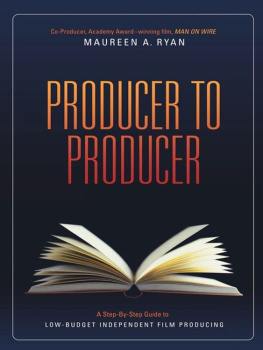Ryan - Sample Size Determination and Power
Here you can read online Ryan - Sample Size Determination and Power full text of the book (entire story) in english for free. Download pdf and epub, get meaning, cover and reviews about this ebook. City: Hoboken;N.J, year: 2013, publisher: John Wiley and Sons, genre: Romance novel. Description of the work, (preface) as well as reviews are available. Best literature library LitArk.com created for fans of good reading and offers a wide selection of genres:
Romance novel
Science fiction
Adventure
Detective
Science
History
Home and family
Prose
Art
Politics
Computer
Non-fiction
Religion
Business
Children
Humor
Choose a favorite category and find really read worthwhile books. Enjoy immersion in the world of imagination, feel the emotions of the characters or learn something new for yourself, make an fascinating discovery.

- Book:Sample Size Determination and Power
- Author:
- Publisher:John Wiley and Sons
- Genre:
- Year:2013
- City:Hoboken;N.J
- Rating:3 / 5
- Favourites:Add to favourites
- Your mark:
- 60
- 1
- 2
- 3
- 4
- 5
Sample Size Determination and Power: summary, description and annotation
We offer to read an annotation, description, summary or preface (depends on what the author of the book "Sample Size Determination and Power" wrote himself). If you haven't found the necessary information about the book — write in the comments, we will try to find it.
Ryan: author's other books
Who wrote Sample Size Determination and Power? Find out the surname, the name of the author of the book and a list of all author's works by series.
Sample Size Determination and Power — read online for free the complete book (whole text) full work
Below is the text of the book, divided by pages. System saving the place of the last page read, allows you to conveniently read the book "Sample Size Determination and Power" online for free, without having to search again every time where you left off. Put a bookmark, and you can go to the page where you finished reading at any time.
Font size:
Interval:
Bookmark:

WILEY SERIES IN PROBABILITY AND STATISTICS
Established by WALTER A. SHEWHART and SAMUEL S. WILKS
Editors: David J. Balding, Noel A. C. Cressie, Garrett M. Fitzmaurice,
Harvey Goldstein, Iain M. Johnstone, Geert Molenberghs, David W. Scott,
Adrian F. M. Smith, Ruey S. Tsay, Sanford Weisberg
Editors Emeriti: Vic Barnett, J. Stuart Hunter, Joseph B. Kadane, Jozef L. Teugels
A complete list of the titles in this series appears at the end of this volume.

Cover design: John Wiley & Sons, Inc.
Cover image: Thomas P. Ryan
Copyright 2013 by John Wiley & Sons, Inc. All rights reserved.
Published by John Wiley & Sons, Inc., Hoboken, New Jersey.
Published simultaneously in Canada.
No part of this publication may be reproduced, stored in a retrieval system, or transmitted in any form or by any means, electronic, mechanical, photocopying, recording, scanning, or otherwise, except as permitted under Section 107 or 108 of the 1976 United States Copyright Act, without either the prior written permission of the Publisher, or authorization through payment of the appropriate per-copy fee to the Copyright Clearance Center, Inc., 222 Rosewood Drive, Danvers, MA 01923, (978) 750-8400, fax (978) 750-4470, or on the web at www.copyright.com . Requests to the Publisher for permission should be addressed to the Permissions Department, John Wiley & Sons, Inc., 111 River Street, Hoboken, NJ 07030, (201) 748-6011, fax (201) 748-6008, or online at http://www.wiley.com/go/permission .
Limit of Liability/Disclaimer of Warranty: While the publisher and author have used their best efforts in preparing this book, they make no representations or warranties with respect to the accuracy or completeness of the contents of this book and specifically disclaim any implied warranties of merchantability or fitness for a particular purpose. No warranty may be created or extended by sales representatives or written sales materials. The advice and strategies contained herein may not be suitable for your situation. You should consult with a professional where appropriate. Neither the publisher nor author shall be liable for any loss of profit or any other commercial damages, including but not limited to special, incidental, consequential, or other damages.
For general information on our other products and services or for technical support, please contact our Customer Care Department within the United States at (800) 762-2974, outside the United States at (317) 572-3993 or fax (317) 572-4002.
Wiley also publishes its books in a variety of electronic formats. Some content that appears in print may not be available in electronic formats. For more information about Wiley products, visit our web site at www.wiley.com .
Library of Congress Cataloging-in-Publication Data:
Ryan, Thomas P., 1945
Sample size determination and power / Thomas P. Ryan.
p. ; cm.
Includes bibliographical references and index.
ISBN 978-1-118-43760-5 (cloth)
I. Title.
[DNLM: 1. Sample Size. 2. Clinical Trials as Topic. 3. Mathematical Computing. 4. Regression Analysis. 5. Sampling Studies. WA 950]
615.50724dc23
2013000329
Preface
Determining a good sample size to use in a scientific study is of utmost importance, especially in clinical studies with some participants receiving a placebo or nothing at all and others taking a drug whose efficacy has not been established. It is imperative that a large enough sample be used so that an effect that is large enough to be of practical significance has a high probability of being detected from the study. That is, the study should have sufficient power . It is also important that sample sizes not be larger than necessary so that the cost of a study not be any larger than necessary and to minimize risk to human subjects in drug studies.
Compared to other subjects in the field of statistics, there is a relative paucity of books on sample size determination and power, especially general purpose books. The classic book on the subject has for decades been Jacob Cohen's Statistical Power Analysis for the Behavioral Sciences , the second edition of which was published in 1988. That book is oriented, as the title indicates, toward the behavioral sciences, with the statistical methodology being quite useful in the behavioral sciences. The second edition has 567 numbered pages, 208 of which are tables, reflecting the noncomputer age in which the two editions of the book were written. In contrast, the relatively recent book by Patrick Dattalo, Determining Sample Size : Balancing Power, Precision, and Practicality (2008), which is part of the series in Pocket Guides to Social Work Research Methods, is 167 pages with more than 20% consisting of tables and screen displays reflecting the now heavy reliance on software for sample size determination. An even smaller book is Sample Size Methodology (1990) by Desu and Raghavarao at 135 pages, while How Many Subjects : Statistical Power Analysis in Research (1987) by Kraemer and Thiemann is just 120 pages and was stated in a review as being an extension of a 1985 journal article by Kraemer. Sample-Size Determination (1964) by Mace is larger at 226 pages and Sample Size Choice : Charts for Experimenters , 2nd ed. (1991) by Odeh and Fox is 216 pages. Thus, some rather small books have been published on the subject, with almost all of these books having been published over 20 years ago.
At the other extreme in terms of size, focus, and mathematical sophistication, there are books on sample determination for clinical studies, such as Sample Size Calculations in Clinical Research , 2nd ed. (2008) by Chow, Shao, and Wang, that are mathematically sophisticated, with the title of this book perhaps suggesting that. A similar recent book is Sample Sizes for Clinical Trials (2010) by Julious, whereas Sample Size Calculations : Practical Methods for Engineers and Scientists (2010) by Mathews is oriented toward engineering and industrial applications.
There are additional statistical methods that are useful in fields other than behavioral sciences, social sciences, and clinical trials, however, and during the past two decades new needs for sample size determination have arisen in fields that are part of the advancement of science, such as microarray experiments.
Although many formulas are given in Cohen's book, they are not derived in either the chapters or chapter appendices, so the inquisitive reader is left wondering how the formulas came about.
Software is also not covered in Cohen's book, nor is software discussed in the books by Mathews, Julious or Chow, Shao, and Wang. Software and Java applets for sample size determination are now fairly prevalent and, of course, are more useful than tables since theoretically there are an infinite number of values that could be entered for one or more parameter values. There was a need for a book that has a broader scope than Cohen's book and that gives some of the underlying math for interested readers, as well as having a strong software focus, along the lines of Dattalo's book, but is not too mathematical for a general readership. No such book met these requirements at the time of writing, which is why this book was written.
This book can be used as a reference book as well as a textbook in special topics courses. Software discussion and illustration is integrated with the subject matter, and there is also a summary section on software at the end of most chapters. Mixing software discussion with subject matter may seem unorthodox, but I believe this is the best way to cover the material since almost every experimenter faced with software determination will probably feel the need to use software and should know what is available in terms of various software and applets. So the book is to a significant extent a software guide, with considerable discussion about the capabilities of each software package. There is also a very large number of references, considerably more than in any other book on the subject.
Font size:
Interval:
Bookmark:
Similar books «Sample Size Determination and Power»
Look at similar books to Sample Size Determination and Power. We have selected literature similar in name and meaning in the hope of providing readers with more options to find new, interesting, not yet read works.
Discussion, reviews of the book Sample Size Determination and Power and just readers' own opinions. Leave your comments, write what you think about the work, its meaning or the main characters. Specify what exactly you liked and what you didn't like, and why you think so.


















